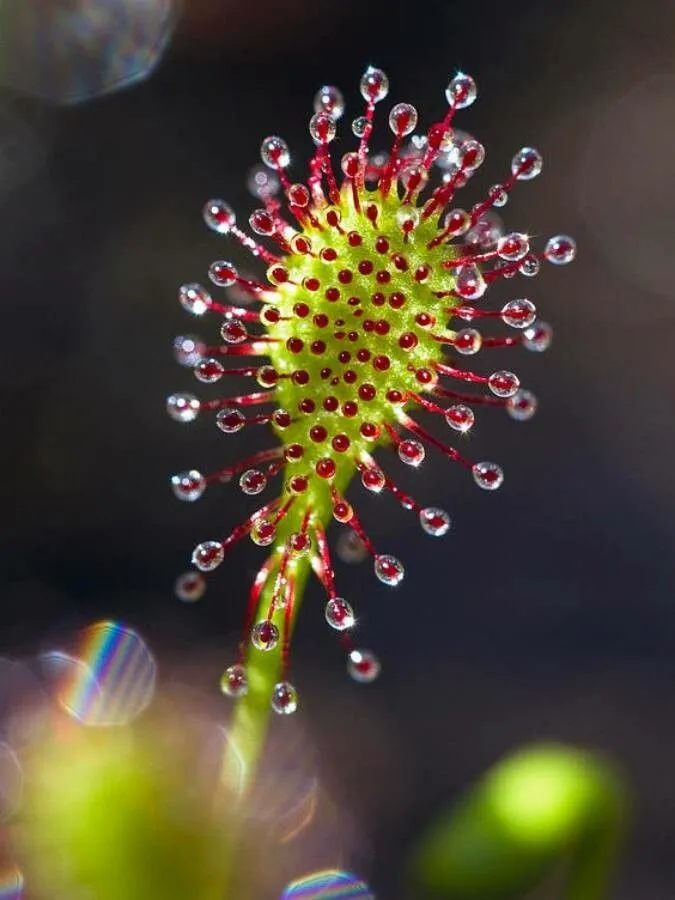
Author: Hayne
Bibliography: J.F.P.Dreves & F.G.Hayne, Bot. Bilderb. 3: 18 (1798)
Year: 1798
Status: accepted
Rank: species
Genus: Drosera
Vegetable: Unknown
Observations: Europe to Türkiye, N. America to E. Brazil
The Oblong-leaf sundew, scientifically known as Drosera intermedia, is a captivating and unique carnivorous plant that belongs to the family Droseraceae. First described in “Botanisches Bilderbuch” by J.F.P. Dreves and F.G. Hayne in 1798, this intriguing species is renowned for its distinctive adaptive features and widespread distribution.
Drosera intermedia is characterized by its elongated leaves, which are covered in sticky glandular hairs. These leaves function as natural insect traps, secreting a sticky, glue-like substance to ensnare unsuspecting prey. This adaptation allows the plant to thrive in nutrient-poor soil conditions by deriving essential nutrients from the insects it captures and digests. The process not only highlights the plant’s survival strategy but also offers a fascinating glimpse into the complexity of plant adaptation and evolution.
The geographical range of the oblong-leaf sundew is quite extensive, spanning across various continents. It can be found in diverse habitats from Europe to Türkiye, and extending westwards to North America and as far south as Eastern Brazil. This broad distribution underscores the plant’s remarkable adaptability to different climates and environmental conditions, from temperate regions to subtropical areas.
The oblong-leaf sundew plays an important ecological role in its native habitats. By controlling insect populations, it helps maintain a balance within its ecosystem. Additionally, it serves as an indicator species for the health of its habitat, given its preference for nutrient-poor, often wet and boggy environments.
In summary, Drosera intermedia is not just a botanical curiosity but also a critical component of its ecosystem. Its unique insect-trapping mechanism, wide distribution, and ecological significance make it a subject of interest for botanists and naturalists alike.
Dan: liden soldug
Deu: mittlerer sonnentau
Eng: oblong-leaf sundew, oblong-leaved sundew, spoonleaf sundew, narrow-leaved sundew, spatulate-leaved sundew, water sundew, spoon-leaved sundew, floating sundew, long-leaved sundew
Nno: dikesoldogg
Nob: dikesoldogg
Fra: droséra intermédiaire, rossolis intermédiaire, rossolis à feuille longue
Nld: kleine zonnedauw
Swe: pikkukihokki, småsileshår, liten daggört
Fin: pikkukihokki
Lav: videja rasene
Cym: gwlithlys hirddail, tawddrudd hirddail
En: Oblong-leaf sundew, Spoonleaf sundew, Oblong-leaved Sundew, Spoon-Leaf Sundew, Narrow-leaved sundew, Spatulate-leaved sundew, Water sundew, Spoon-leaved sundew, Long-Leaved Sundew, Floating sundew
Be: Расіца прамежкавая
Br: Glizheolez-delioù-hir
Zh: 長柄毛氈苔
Cs: Rosnatka prostřední
Da: Liden soldug
Nl: Kleine zonnedauw
Et: Vahelmine huulhein
Fi: Pikkukihokki
Fr: Rossolis intermédiaire, Droséra intermédiaire, Rossolis à feuille longue
De: Mittlerer Sonnentau
Hu: Közepes harmatfű
Ga: Cailís Mhuire
It: Drosera intermedia
Lv: Videja rasene
Lt: Mažalapė saulašarė
No: Dikesoldogg
Nb: Dikesoldogg
Nn: Dikesoldogg
Pl: Rosiczka pośrednia
Ru: Росянка промежуточная
Sv: Småsileshår, Pikkukihokki, Liten daggört
Uk: Росичка середня
Cy: Gwlithlys hirddail, Tawddrudd Hirddail
Taken May 27, 2022 by Tristan Jaton-Maria (cc-by-sa)
Taken Aug 11, 2020 by Groupe Botanique de Bruxelles (cc-by-sa)
Taken Jun 1, 2009 by Maarten Vanhove (cc-by-sa)
Taken Jun 1, 2009 by Maarten Vanhove (cc-by-sa)
Taken Jan 4, 2022 by Nouela (cc-by-sa)
Taken May 20, 2009 by EOL − Gustavo Grandjean (cc-by)
Taken Jul 24, 2018 by Tela Botanica − José Luis Romero Rego (cc-by-sa)
Taken Jun 10, 2009 by EOL − Barry Rice (cc-by-nc-sa)
Taken Aug 16, 2021 by Pierre LEON (cc-by-sa)
Taken Aug 11, 2020 by Groupe Botanique de Bruxelles (cc-by-sa)
Taken May 26, 2022 by Pierre LEON (cc-by-sa)
Taken May 27, 2022 by Tristan Jaton-Maria (cc-by-sa)
Taken May 27, 2022 by Tristan Jaton-Maria (cc-by-sa)
Taken May 27, 2022 by Tristan Jaton-Maria (cc-by-sa)
Taken Jan 4, 2022 by Nouela (cc-by-sa)
Taken Sep 5, 2020 by Marietta Nollen (cc-by-sa)
Taken Sep 14, 2020 by Bettina Campbell (cc-by-sa)
Taken May 12, 2019 by Hugo Meeus (cc-by-sa)
Taken Jul 25, 2019 by Sarah Rougeon (cc-by-sa)
Taken Aug 29, 2014 by Tela Botanica − Aurélien DAVROUX (cc-by-sa)
Taken Aug 15, 2013 by Photoflora – Benoit BOCK (©)
Taken Jan 1, 1970 by Photoflora – L’Abbé COSTE (©)
Taken May 17, 2004 by Tela Botanica − Liliane Roubaudi (cc-by-sa)
Taken Sep 28, 2012 by Tela Botanica − Sven FIGUET (cc-by-sa)
Taken May 31, 1852 by Tela Botanica − Herbier PONTARLIER-MARICHAL (cc-by-sa)
Taken Jul 24, 2018 by Tela Botanica − José Luis Romero Rego (cc-by-sa)
Taken Aug 24, 2013 by EOL − Haley (cc-by-nc)
© copyright of the Board of Trustees of the Royal Botanic Gardens, Kew.
© copyright of the Board of Trustees of the Royal Botanic Gardens, Kew.
Family: Myrtaceae Author: (F.Muell.) K.D.Hill & L.A.S.Johnson Bibliography: Telopea 6: 402 (1995) Year: 1995 Status:…
Family: Rubiaceae Author: Pierre ex A.Froehner Bibliography: Notizbl. Bot. Gart. Berlin-Dahlem 1: 237 (1897) Year:…
Family: Sapindaceae Author: Koidz. Bibliography: J. Coll. Sci. Imp. Univ. Tokyo 32(1): 38 (1911) Year:…
Family: Asteraceae Author: A.Gray Bibliography: Pacif. Railr. Rep.: 107 (1857) Year: 1857 Status: accepted Rank:…
Family: Fabaceae Author: Medik. Bibliography: Vorles. Churpfälz. Phys.-Ökon. Ges. 2: 398 (1787) Year: 1787 Status:…
Family: Aspleniaceae Author: (Cav.) Alston Bibliography: Bull. Misc. Inform. Kew 1932: 309 (1932) Year: 1932…